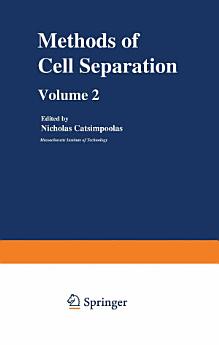Methods of Cell Separation
Nicholas Catsimpoolas
নৱে ২০১৩ · Springer Science & Business Media
ইবুক
313
পৃষ্ঠা
reportমূল্যাংকন আৰু পৰ্যালোচনা সত্যাপন কৰা হোৱা নাই অধিক জানক
এই ইবুকখনৰ বিষয়ে
Presently, the need for methods involving separation, identification, and characterization of different kinds of cells is amply realized among immu nologists, hematologists, cell biologists, clinical pathologists, and cancer researchers. Unless cells exhibiting different functions and stages of differ entiation are separated from one another, it will be exceedingly difficult to study some of the molecular mechanisms involved in cell recognition, specialization, interactions, cytotoxicity, and transformation. Clinical diag nosis of diseased states and use of isolated cells for therapeutic (e. g. , immunotherapy) or survival (e. g. , transfusion) purposes are some of the pressing areas where immediate practical benefits can be obtained by applying cell separation techniques. However, the development of such useful methods is still in its infancy. A number of good techniques exist based either on the physical or biological properties of the cells, and these have produced some valuable results. Still others are to be discovered. Therefore, the purpose of this open-end treatise is to acquaint the reader with some of the basic principles, instrumentation, and procedures pres ently in practice at various laboratories around the world and to present some typical applications of each technique to particular biological prob lems. To this end, I was fortunate to obtain the contribution of certain leading scientists in the field of cell separation, people who in their pioneer ing work have struggled with the particular problems involved in separating living cells and in some way have won.
এই ইবুকখনক মূল্যাংকন কৰক
আমাক আপোনাৰ মতামত জনাওক।
পঢ়াৰ নির্দেশাৱলী
স্মাৰ্টফ’ন আৰু টেবলেট
Android আৰু iPad/iPhoneৰ বাবে Google Play Books এপটো ইনষ্টল কৰক। ই স্বয়ংক্রিয়ভাৱে আপোনাৰ একাউণ্টৰ সৈতে ছিংক হয় আৰু আপুনি য'তে নাথাকক ত'তেই কোনো অডিঅ'বুক অনলাইন বা অফলাইনত শুনিবলৈ সুবিধা দিয়ে।
লেপটপ আৰু কম্পিউটাৰ
আপুনি কম্পিউটাৰৰ ৱেব ব্রাউজাৰ ব্যৱহাৰ কৰি Google Playত কিনা অডিঅ'বুকসমূহ শুনিব পাৰে।
ই-ৰীডাৰ আৰু অন্য ডিভাইচ
Kobo eReadersৰ দৰে ই-চিয়াঁহীৰ ডিভাইচসমূহত পঢ়িবলৈ, আপুনি এটা ফাইল ডাউনল’ড কৰি সেইটো আপোনাৰ ডিভাইচলৈ স্থানান্তৰণ কৰিব লাগিব। সমৰ্থিত ই-ৰিডাৰলৈ ফাইলটো কেনেকৈ স্থানান্তৰ কৰিব জানিবলৈ সহায় কেন্দ্ৰত থকা সবিশেষ নিৰ্দেশাৱলী চাওক।







